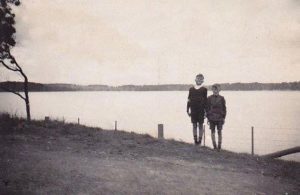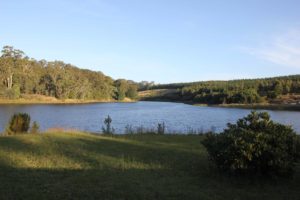
From Ballarat Illustrated
Water has been a source of consternation in Victoria, from the time of the early settlers to the present day, and its scarcity (or over abundance) has produced many changes. Overlanders like John Stuart Hepburn, John Gardiner and Joseph Hawdon were some of the first to cross the Murray River, which was very low so that they could easily pass the stock over. At the Ovens they also found a dry riverbed. Hepburn was later to settle at Smeaton Hill in 1838.
Soon after the overlanders, many other early settlers arrived in the district near Ballarat now known as Burrumbeet. William Bramwell Withers recounting in his ‘History of Ballarat’ describes hot days and freezing cold nights, so much so, that the early pioneers’ camping place, near Burrumbeet, was named Mt Misery.
The next year, 1839, the bed of Lake Burrumbeet was quite dry, and it remained so for several succeeding summers, when Mrs Andrew Scott drove across the dry lake bed in 1840. Withers describes her as being the first lady who travelled through the district.
In the ensuing years there were droughts and floods, and many colourful discussions between the Ballarat East and Ballarat councils about the provision of water to the civic centres in the Ballarat district.
The first attempt at a Ballarat town water supply was made in December 1852. Men were employed to build a small dam across the Gnarr Creek, adjacent to what is now the Ballarat Railway Station. This little dam mainly served the Government Camp which was between Lydiard and Camp Streets. For some years Yuille’s Swamp (now Lake Wendouree) was the main water supply for Ballarat.

Kirk’s Reservoir near Ballarat.
One of the first reservoirs in the district was made by Mr Kirk to supply water for mining purposes. This reservoir was eventually taken over by the councils in June 1862. The Ballarat and Ballarat East Water Supply Committee in 1870 had under its control 3000 acres of land and Beale’s, Pincott’s and Kirk’s Reservoirs with total storage capacity of 294,000,000 gallons, supplying water to 5,000 houses, 40 manufacturers and 16 mines. The Gong Gong Reservoir was the fourth dam built, while the White Swan was constructed in later years.
The foresight of our early pioneers, in constructing a series of reservoirs, and their understanding of the need for a constant supply of clean, fresh water was remarkable and has served the citizens of Ballarat well.
In the international year of ‘Water’ Antarctic explorer and ecologist Peter Malcolm spoke on ‘Fresh Water or Putrid Water? It’s our Choice – A story about Creating Change?’ on Thursday 4th September at 8.00pm, at Australian Catholic University, 1200 Mair Street, Ballarat. The lecture was free and open to the public.
